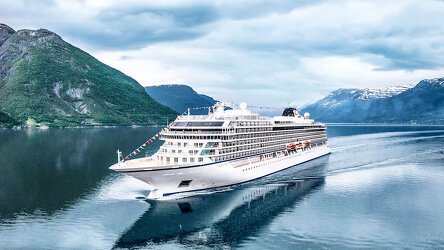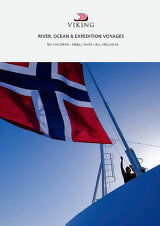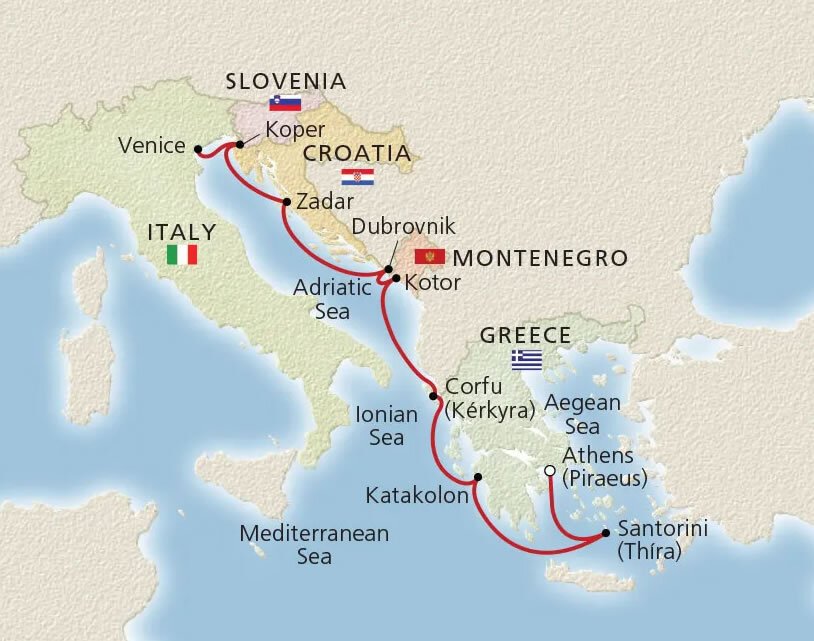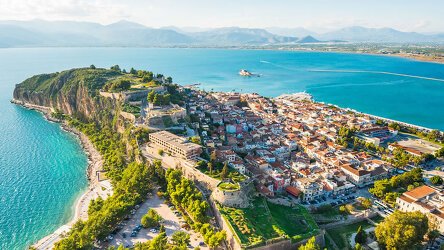Overview
Itinerary
Embark your ship and settle into your stateroom. Chioggia is a charming fishing community steeped in its age-old seafaring traditions. It is also the gateway to Venice, famed for its wondrous patchwork of graceful piazzas, tranquil canals, artful footbridges and Gothic splendor. All things Venetian begin in St. Mark's Square, where its elegant campanile, or bell tower, rings over the rooftops, and the Byzantine-Gothic St. Mark's Basilica seems to preside over all. Beyond St. Mark's and away from the crowds, Venice is a hushed and intriguing city to explore on foot, with medieval echoes marking every step.
Koper boasts a rich architectural legacy that dates back to its days as a capital city under the mighty Venetian Republic. Even today, the Italian influence is strong; as this historic city is near the Italian border, Slovene and Italian are equally likely to be heard here. In Tito Square, the Venetian-Gothic Praetorian Palace stands as evidence of the city's once great power. The 12th-century Cathedral of the Assumption is home to a bell cast in 1333, one of the country's oldest. A climb up its tower is rewarded with splendid views of the city and the Gulf of Trieste.
Zadar, once an island separated from the mainland by a deep moat, boasts one of the region's richest histories. For over a millennium, it was the capital of independent Dalmatia and so held great sway with Rome, Venice and other empires. Its impressive city walls attest to its might, and the bold Romanesque architecture of its three churches embodies its religious influence. A maze of cobblestone streets winds through its magnificent Old Town, a remarkable repository of red-roofed, medieval stone houses.
Dubrovnik is a historic jewel, with its spectacular Adriatic setting, 12th-century medieval streets and incredibly preserved structures. So stunning is its Old Town, the playwright George Bernard Shaw famously called it “paradise on Earth.” It is all spectacularly surrounded by a towering medieval wall. Inside, the ancient city's Stradun is lined with authentic stone houses. The peaceful 14th-century Franciscan Monastery and Apothecary, housing the world's oldest working pharmacy and fine collection of Renaissance paintings, provide insight into the ages.
Kotor is Montenegro's picturesque capital set amid glorious mountains and dramatic scenery. Towering cliffs soar above the narrow Kotor ria—a submerged river canyon often called Europe's southernmost fjord. Kotor is also home to one of the Adriatic's best-preserved medieval Old Towns. The charms of this red-roofed city are endless, from the mismatched towers of its Romanesque cathedral to its narrow streets. Its stunning Venetian walls were built in 1420, remnants from Kotor's nearly 300 years as a province of the Venetian Republic.
Corfu has a rich history shaped by conquerors and by royalty seeking tranquility. Corfu's Old Town and Fortress—fashioned by the once powerful Venetian Republic—comprise a UNESCO World Heritage Site. Its narrow warrens lead to one of Europe's largest public squares and a lovely promenade once exclusively reserved for the local aristocracy. Everywhere, magnificent coastal views unfold and scenic byways lead to history-rich enclaves, from the archaeological site of Paleopolis and the stunning Vlacherna Monastery to a former Greek royal villa.
Katakolon is huddled around a pretty little harbor dotted with colorful fishing boats. Nearby, the fertile valleys of the western Peloponnese are a bounty of olive groves, vineyards and orchards, and lead to the legendary city of Olympia. The well-kept ruins here transport visitors back to the days of the earliest athletes who competed for nothing less than the favor of the gods. The remains evoke the glory of the Games, and the Olympia Archaeological Museum features statues that once overlooked the site.
Santorini is one of the most visually arresting islands in the Aegean. Its whitewashed capital of Thíra perches on a cliff 1,300 feet above the sea, offering spectacular views of this magnificent city and surrounding turquoise waters. Thíra's winding streets are a delight to explore and its charming cafés invite lingering respites in the Cyclades sun. Not to be upstaged, the island and its surrounding islets also offer opportunities to experience fully the natural volcanic splendor, from thermal spring soaks to caldera hikes.
Athens has been called the “birthplace of democracy.” Its legacy looms large from atop Acropolis Hill, the pinnacle of ancient Greece. This open air museum is an astonishing repository of once-mighty structures. From its colonnaded Parthenon—more than 2,600 years ago—revered Greek philosophers like Plato and Aristotle formulated new ideas of government and debated its role in civic life to captivated audiences. Remnants of spiritual life are also here in the several temples to Athena and Zeus.
For a more intimate experience of Athens, the charming Plaka District invites guests with its labyrinth of cobblestone lanes. Neoclassical architecture lines the narrow streets of the “Neighborhood of the Gods,” so named for its location. Browsing its shops or simply perusing its nooks and crannies are pastimes favored by visitors and locals alike. This historic area is the ideal setting in which to enjoy traditional small plates of mezes and a sip of ouzo. After breakfast, disembark your ship and journey home.
Life Onboard Viking Jupiter

Launched in 2019, the Viking Jupiter is Vikings' newest all-veranda ship, part of a fleet of award winning, state of the art ships incorporating all the comforts & luxuries you would expect from Viking. Read more

Viking are destination experts. With no casinos or children on board, you can be assured that the focus is firmly on enrichment and education. Read more

After a day of exploration or just to enhance the relaxation of a day at sea, the on-board Spa will leave you feeling recharged and revitalized. Read more

Viking offer eight on board dining options. Beer, wine and soft drinks are available with lunch and dinner at no additional charge of fee. Read more

Viking proudly includes all that you need and nothing you do not. A variety of features and services valued at $200 per person per day are standard inclusions in your cruise. Read more

Viking include one complimentary shore excursion in every port of call. Enjoy exclusive entry to cultural treasures and seldom-seen collections around the world. Read more

Trip Reviews (6) Most Recent 'Empires of the Mediterranean' Reviews
On board with Viking Star, we once again booked the Penthouse Verandah suite….just sensational on all avenues. Our experiences on ship were all a 10 out of 10. All staff members are genuinely friendly and helpful… through the roof. The restaurant venues and choices are second to none. l must say, the quality and range of options is outstanding. I must say, it’s not difficult to understand why people continue to travel with Viking. It really is a case of ‘when you travel with the best, forget the rest. Many thanks Viking… our next adventure with you is now very close.
Brochure

Viking River, Ocean & Expedition Voyages (2025-27)
Availability
 USD
Port charges, taxes and fees included.
USD
Port charges, taxes and fees included.
Viking Cruise $25 Deposits!
Tour & cruises prices are per person. Prices shown have savings applied, are subject to availability and may be withdrawn at any time without notice. Pricing and trip details are correct at this point in time, however are subject to confirmation at the time of booking and are subject to change by Viking. For cruise itineraries, cabin images are sourced from Viking. These should be treated as indicative only. Cabin inclusions, upholsteries and room layout may differ to the image(s) shown depending on the ship selected and your sailing dates.









